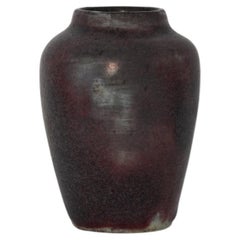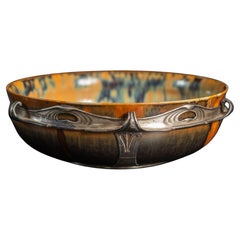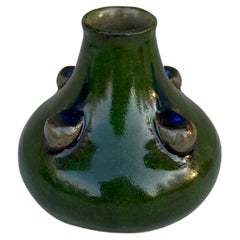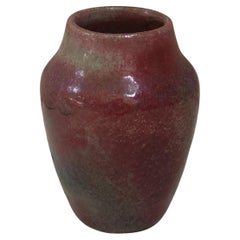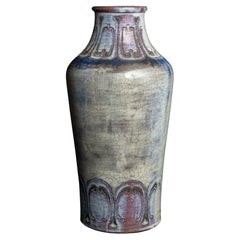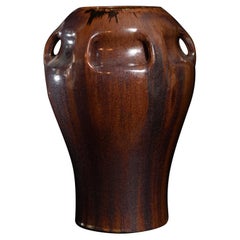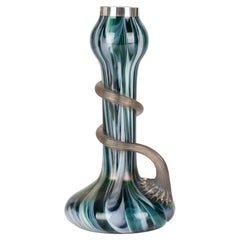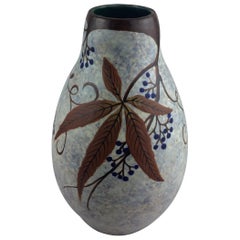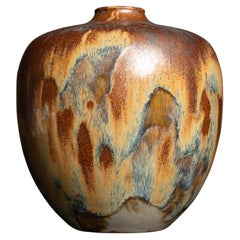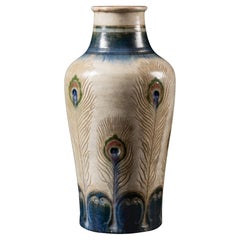Auguste Delaherche Furniture
Auguste Delaherche turned the science of experimentation in ceramic ware into an art form. Coming from a long tradition of potters in the Beauvais region of France dating back to antiquity, Delaherche displayed a fascination and an appreciation for ceramics from an early age.
After studies in Paris at the Ecole des Arts Decoratifs, Delaherche worked for several years producing utilitarian salt-glazed stoneware. Like Ernest Chaplet, from whom he bought his Vaugirard workshop in 1887, Delaherche was an innovator; he saw artistic merit and the untapped potential of stoneware. He worked exclusively with this material, which was very rare for the period. Inspired by enameled Japanese stoneware, he perfected his enamel glazing techniques during this time that are characterized by subtle gradations of tone.
A consummate experimental potter, Delaherche was disciplined and methodical. He had exhibited his work at the Union Centrale des Arts Decoratifs in Paris, but it was at the Exposition Universelle of 1889, where he won a gold medal, that he received both critical and popular acclaim.
For Delaherche, there was always more to learn and more to master. By 1894, he left Paris for the hamlet of Armentieres located nearby to his native Beauvais. From his atelier, which he called les Sables Rouges (the red sands), Delaherche’s work shows adherence to modernist principles in privileging the formal qualities to achieve overall abstraction.
Assisted only by his wife, Delaherche preferred autonomous control and had no tolerance for the unexpected effects sometimes produced during the firing process. With sobriety and a disciplined approach to his work, Delaherche would destroy any piece that did not demonstrate complete mastery of the artistic process.
Find Auguste Delaherche ceramics for sale on 1stDibs.
(Biography provided by Galerie Fledermaus)
1890s French Art Deco Antique Auguste Delaherche Furniture
Stoneware
Early 1900s French Art Nouveau Antique Auguste Delaherche Furniture
Silver
1930s French Japonisme Vintage Auguste Delaherche Furniture
Pottery
1930s French Japonisme Vintage Auguste Delaherche Furniture
Pottery
1880s French Art Nouveau Antique Auguste Delaherche Furniture
Stoneware
1880s French Art Nouveau Antique Auguste Delaherche Furniture
Stoneware
1880s French Art Nouveau Antique Auguste Delaherche Furniture
Stoneware
Late 19th Century French Art Nouveau Antique Auguste Delaherche Furniture
Stoneware
Early 1900s Austrian Art Nouveau Antique Auguste Delaherche Furniture
Silver
Early 20th Century French Art Deco Auguste Delaherche Furniture
Ceramic
Early 20th Century French Art Nouveau Auguste Delaherche Furniture
Ceramic
Early 1900s French Art Nouveau Antique Auguste Delaherche Furniture
Crystal
Early 20th Century Belgian Auguste Delaherche Furniture
Glass
1890s French Art Nouveau Antique Auguste Delaherche Furniture
Art Glass
20th Century French Art Nouveau Auguste Delaherche Furniture
Glass
21st Century and Contemporary Chinese Other Auguste Delaherche Furniture
Ceramic, Pottery
1930s American Art Deco Vintage Auguste Delaherche Furniture
Ceramic, Pottery
1890s English Art Nouveau Antique Auguste Delaherche Furniture
Crystal
Early 1900s French Art Nouveau Antique Auguste Delaherche Furniture
Art Glass
Early 1900s French Art Nouveau Antique Auguste Delaherche Furniture
Stoneware
Early 1900s French Art Nouveau Antique Auguste Delaherche Furniture
Stoneware
1880s French Art Nouveau Antique Auguste Delaherche Furniture
Stoneware
1930s French Japonisme Vintage Auguste Delaherche Furniture
Pottery
Early 19th Century Antique Auguste Delaherche Furniture
Ceramic
1920s French Art Deco Vintage Auguste Delaherche Furniture
Ceramic
Early 20th Century French Art Nouveau Auguste Delaherche Furniture
Bronze
